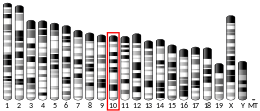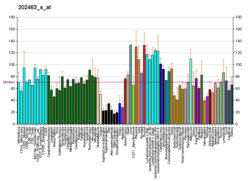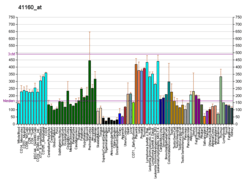MBD3
Methyl-CpG-binding domain protein 3 is a protein that in humans is encoded by the MBD3 gene.[5][6][7]
Function
DNA methylation is the major modification of eukaryotic genomes and plays an essential role in mammalian development. Human proteins MECP2, MBD1, MBD2, MBD3, and MBD4 comprise a family of nuclear proteins related by the presence in each of a methyl-CpG binding domain (MBD). However, unlike the other family members, MBD3 is not capable of binding to methylated DNA but instead binds to hydroxymethylated DNA.[8] The predicted MBD3 protein shares 71% and 94% identity with MBD2 (isoform 1) and mouse Mbd3. MBD3 is a subunit of the NuRD, a multisubunit complex containing nucleosome remodeling and histone deacetylase activities. MBD3 mediates the association of metastasis-associated protein 2 (MTA2) with the core histone deacetylase complex.[7]
MBD3 also contains the coiled‐coil domain common to all three MBD3 isoforms. The coiled‐coil domain, but not the MBD domain, helps to maintain pluripotency of embryonic stem cells via the recruitment of polycomb repressive complex 2 to a subset of genes linked to development and organogenesis, thus establishing stable transcriptional repression.[9]
Interactions
MBD3 has been shown to interact with:
References
- GRCh38: Ensembl release 89: ENSG00000071655 - Ensembl, May 2017
- GRCm38: Ensembl release 89: ENSMUSG00000035478 - Ensembl, May 2017
- "Human PubMed Reference:". National Center for Biotechnology Information, U.S. National Library of Medicine.
- "Mouse PubMed Reference:". National Center for Biotechnology Information, U.S. National Library of Medicine.
- Hendrich B, Bird A (November 1998). "Identification and characterization of a family of mammalian methyl-CpG binding proteins". Molecular and Cellular Biology. 18 (11): 6538–47. doi:10.1128/mcb.18.11.6538. PMC 109239. PMID 9774669.
- Hendrich B, Abbott C, McQueen H, Chambers D, Cross S, Bird A (September 1999). "Genomic structure and chromosomal mapping of the murine and human Mbd1, Mbd2, Mbd3, and Mbd4 genes". Mammalian Genome. 10 (9): 906–12. doi:10.1007/s003359901112. PMID 10441743.
- "Entrez Gene: MBD3 methyl-CpG binding domain protein 3".
- Yildirim O, Li R, Hung JH, Chen PB, Dong X, Ee LS, Weng Z, Rando OJ, Fazzio TG (December 2011). "Mbd3/NURD complex regulates expression of 5-hydroxymethylcytosine marked genes in embryonic stem cells". Cell. 147 (7): 1498–510. doi:10.1016/j.cell.2011.11.054. PMC 3252821. PMID 22196727.
- Hirasaki M, Ueda A, Asaka MN, Uranishi K, Suzuki A, Kohda M, Mizuno Y, Okazaki Y, Nishimoto M, Sharif J, Koseki H, Okuda A (May 2018). "Identification of the Coiled-Coil Domain as an Essential Mbd3 Element for Preserving Lineage Commitment Potential of Embryonic Stem Cells". Stem Cells. 36 (9): 1355–1367. doi:10.1002/stem.2849. PMID 29761578.
- Sakai H, Urano T, Ookata K, Kim MH, Hirai Y, Saito M, Nojima Y, Ishikawa F (December 2002). "MBD3 and HDAC1, two components of the NuRD complex, are localized at Aurora-A-positive centrosomes in M phase". The Journal of Biological Chemistry. 277 (50): 48714–23. doi:10.1074/jbc.M208461200. PMID 12354758.
- Brackertz M, Boeke J, Zhang R, Renkawitz R (October 2002). "Two highly related p66 proteins comprise a new family of potent transcriptional repressors interacting with MBD2 and MBD3". The Journal of Biological Chemistry. 277 (43): 40958–66. doi:10.1074/jbc.M207467200. PMID 12183469.
- Feng Q, Cao R, Xia L, Erdjument-Bromage H, Tempst P, Zhang Y (January 2002). "Identification and functional characterization of the p66/p68 components of the MeCP1 complex". Molecular and Cellular Biology. 22 (2): 536–46. doi:10.1128/MCB.22.2.536-546.2002. PMC 139742. PMID 11756549.
- Zhang Y, Ng HH, Erdjument-Bromage H, Tempst P, Bird A, Reinberg D (August 1999). "Analysis of the NuRD subunits reveals a histone deacetylase core complex and a connection with DNA methylation". Genes & Development. 13 (15): 1924–35. doi:10.1101/gad.13.15.1924. PMC 316920. PMID 10444591.
- Saito M, Ishikawa F (September 2002). "The mCpG-binding domain of human MBD3 does not bind to mCpG but interacts with NuRD/Mi2 components HDAC1 and MTA2". The Journal of Biological Chemistry. 277 (38): 35434–9. doi:10.1074/jbc.M203455200. PMID 12124384.
- Jiang CL, Jin SG, Pfeifer GP (December 2004). "MBD3L1 is a transcriptional repressor that interacts with methyl-CpG-binding protein 2 (MBD2) and components of the NuRD complex". The Journal of Biological Chemistry. 279 (50): 52456–64. doi:10.1074/jbc.M409149200. PMID 15456747.
Further reading
- Shen L, Zhang Y (June 2013). "5-Hydroxymethylcytosine: generation, fate, and genomic distribution". Current Opinion in Cell Biology. 25 (3): 289–96. doi:10.1016/j.ceb.2013.02.017. PMC 4060438. PMID 23498661.
- Abbott WM, Mellor A, Edwards Y, Feizi T (April 1989). "Soluble bovine galactose-binding lectin. cDNA cloning reveals the complete amino acid sequence and an antigenic relationship with the major encephalitogenic domain of myelin basic protein". The Biochemical Journal. 259 (1): 283–90. doi:10.1042/bj2590283. PMC 1138502. PMID 2470348.
- Zhang Y, LeRoy G, Seelig HP, Lane WS, Reinberg D (October 1998). "The dermatomyositis-specific autoantigen Mi2 is a component of a complex containing histone deacetylase and nucleosome remodeling activities". Cell. 95 (2): 279–89. doi:10.1016/S0092-8674(00)81758-4. PMID 9790534.
- Tong JK, Hassig CA, Schnitzler GR, Kingston RE, Schreiber SL (October 1998). "Chromatin deacetylation by an ATP-dependent nucleosome remodelling complex". Nature. 395 (6705): 917–21. Bibcode:1998Natur.395..917T. doi:10.1038/27699. PMID 9804427.
- Zhang Y, Ng HH, Erdjument-Bromage H, Tempst P, Bird A, Reinberg D (August 1999). "Analysis of the NuRD subunits reveals a histone deacetylase core complex and a connection with DNA methylation". Genes & Development. 13 (15): 1924–35. doi:10.1101/gad.13.15.1924. PMC 316920. PMID 10444591.
- Wade PA, Gegonne A, Jones PL, Ballestar E, Aubry F, Wolffe AP (September 1999). "Mi-2 complex couples DNA methylation to chromatin remodelling and histone deacetylation". Nature Genetics. 23 (1): 62–6. doi:10.1038/12664. PMID 10471500.
- Tatematsu KI, Yamazaki T, Ishikawa F (August 2000). "MBD2-MBD3 complex binds to hemi-methylated DNA and forms a complex containing DNMT1 at the replication foci in late S phase". Genes to Cells. 5 (8): 677–88. doi:10.1046/j.1365-2443.2000.00359.x. PMID 10947852.
- Humphrey GW, Wang Y, Russanova VR, Hirai T, Qin J, Nakatani Y, Howard BH (March 2001). "Stable histone deacetylase complexes distinguished by the presence of SANT domain proteins CoREST/kiaa0071 and Mta-L1". The Journal of Biological Chemistry. 276 (9): 6817–24. doi:10.1074/jbc.M007372200. PMID 11102443.
- Shi Y, Downes M, Xie W, Kao HY, Ordentlich P, Tsai CC, Hon M, Evans RM (May 2001). "Sharp, an inducible cofactor that integrates nuclear receptor repression and activation". Genes & Development. 15 (9): 1140–51. doi:10.1101/gad.871201. PMC 312688. PMID 11331609.
- Feng Q, Cao R, Xia L, Erdjument-Bromage H, Tempst P, Zhang Y (January 2002). "Identification and functional characterization of the p66/p68 components of the MeCP1 complex". Molecular and Cellular Biology. 22 (2): 536–46. doi:10.1128/MCB.22.2.536-546.2002. PMC 139742. PMID 11756549.
- Schlegel J, Güneysu S, Mennel HD (2002). "Expression of the genes of methyl-binding domain proteins in human gliomas". Oncology Reports. 9 (2): 393–5. doi:10.3892/or.9.2.393. PMID 11836615.
- Saito M, Ishikawa F (September 2002). "The mCpG-binding domain of human MBD3 does not bind to mCpG but interacts with NuRD/Mi2 components HDAC1 and MTA2". The Journal of Biological Chemistry. 277 (38): 35434–9. doi:10.1074/jbc.M203455200. PMID 12124384.
- Brackertz M, Boeke J, Zhang R, Renkawitz R (October 2002). "Two highly related p66 proteins comprise a new family of potent transcriptional repressors interacting with MBD2 and MBD3". The Journal of Biological Chemistry. 277 (43): 40958–66. doi:10.1074/jbc.M207467200. PMID 12183469.
- Sakai H, Urano T, Ookata K, Kim MH, Hirai Y, Saito M, Nojima Y, Ishikawa F (December 2002). "MBD3 and HDAC1, two components of the NuRD complex, are localized at Aurora-A-positive centrosomes in M phase". The Journal of Biological Chemistry. 277 (50): 48714–23. doi:10.1074/jbc.M208461200. PMID 12354758.
- Fujita N, Jaye DL, Kajita M, Geigerman C, Moreno CS, Wade PA (April 2003). "MTA3, a Mi-2/NuRD complex subunit, regulates an invasive growth pathway in breast cancer". Cell. 113 (2): 207–19. doi:10.1016/S0092-8674(03)00234-4. PMID 12705869.
- Fujita N, Jaye DL, Geigerman C, Akyildiz A, Mooney MR, Boss JM, Wade PA (October 2004). "MTA3 and the Mi-2/NuRD complex regulate cell fate during B lymphocyte differentiation". Cell. 119 (1): 75–86. doi:10.1016/j.cell.2004.09.014. PMID 15454082.





